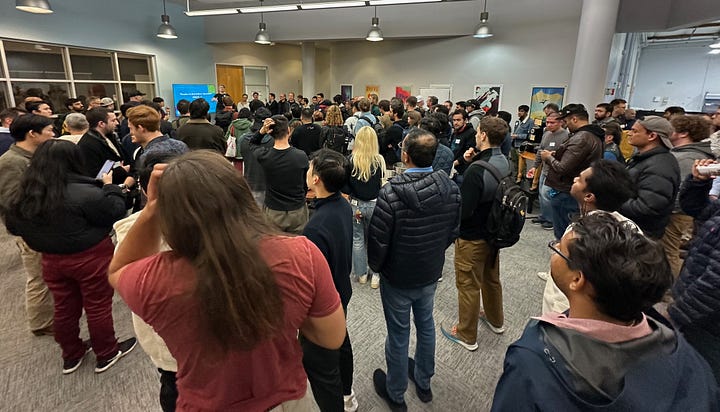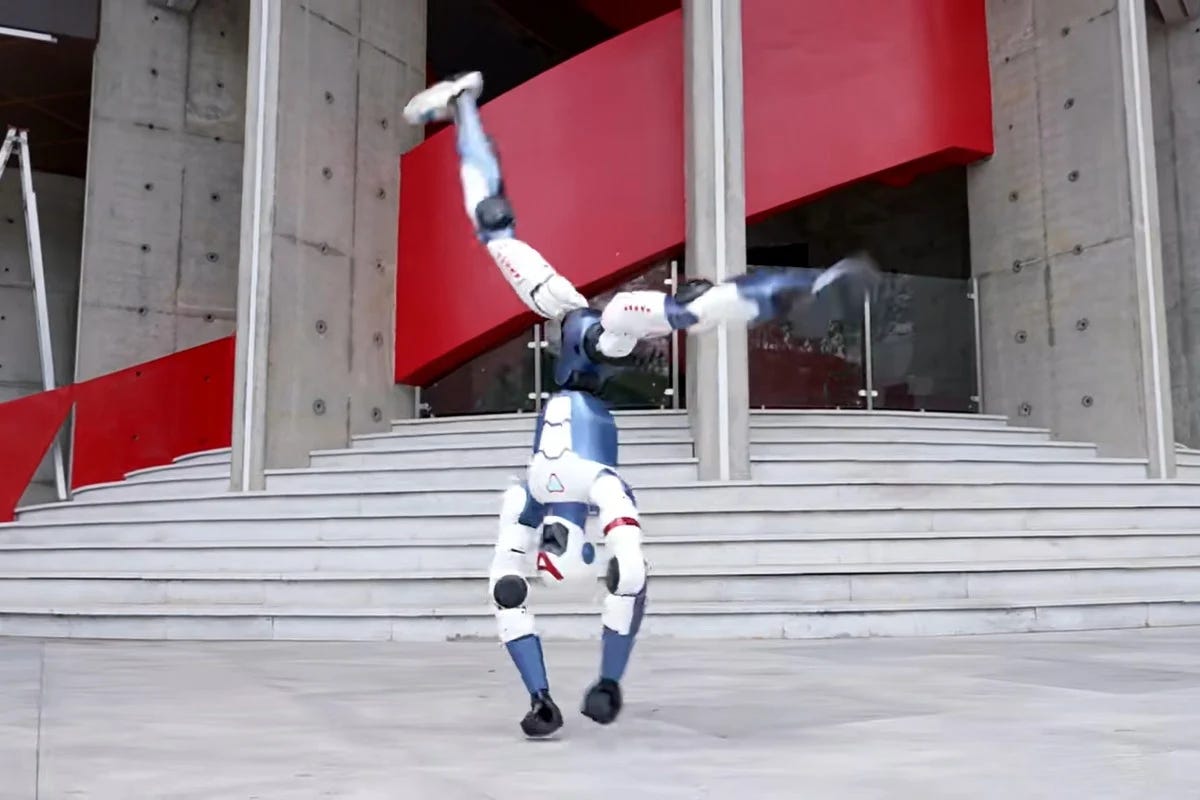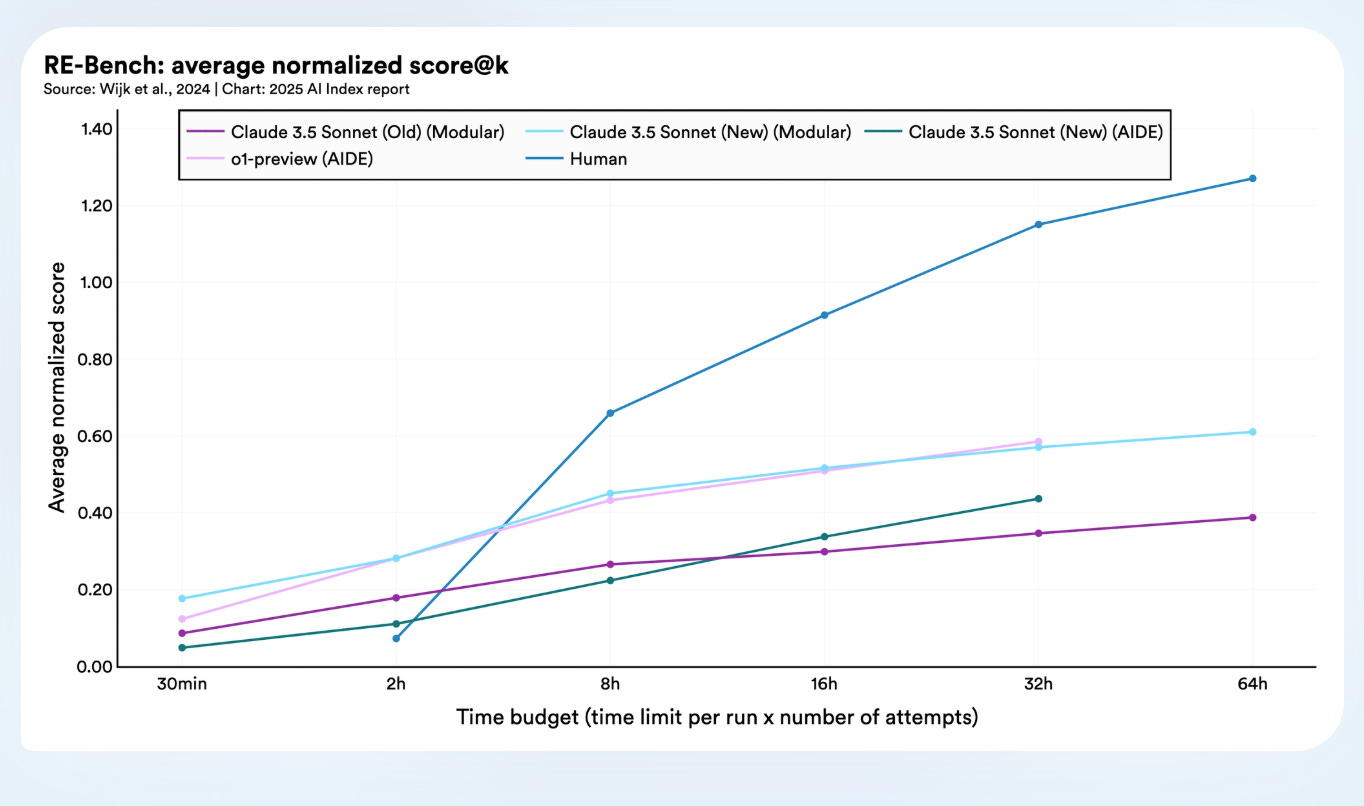Another affordable humanoid robot hits the streets
Bonsai Robotics acquires farm-ng, bringing intelligent autonomy to modular EV agmachinery
Barely one week after Unitree announced IPO plans, they’ve launched the R1, an ultra affordable (US $5900) light weight humanoid robot.
Marketed as “born for sport”, the R1 was seen doing a cartwheel, walking on its “hands”, throwing a punch, lying down then standing up, and running down a hill, according to a video posted on Chinese social media on Friday.
The machine weighs 25 kilograms and features 26 joints. The company has not disclosed other details.
The R1 is the cheapest humanoid robot from the Hangzhou, Zhejiang province-based unicorn. Two earlier models, the G1 which stands 130cm tall and weighs 35kg, and the H1 at 180cm and weighing 47kg, start at 99,000 yuan and 650,000 yuan, respectively. (via South China Morning Post)
The only more affordable humanoid robot on the market at the moment is Hugging Face’s Hope Junior, an open source 3D printable robot.
Meanwhile TESLA is falling short of its goal to produce 5,000 Optimus humanoids this year, with fewer than 50 deployed for testing in their Palo Alto facility. According to The Information, the Fremont Optimus production line is on hold while the Optimus team work out how to produce useful robot hands.
This March, Musk outlined the goal of making at least 5,000 Optimus robots in 2025 and 10 times that number in 2026 during a Tesla all-hands meeting. In 2027, Musk has said, Tesla plans to send an Optimus robot aboard a SpaceX rocket to walk on Mars. During Tesla’s earnings call this Wednesday, Musk said he would be “shocked” if Tesla isn’t making 100,000 Optimus robots per month in 2030.
Of course many of the humanoid robots in production today are capable of doing work without needing sophisticated hands. Digit, from Agility Robotics, is a great example. However, we do expect to see dancing and drink serving robots showing off at Elon’s November shareholder meeting.
What’s wrong with the Turing Test?
Alan Turing’s original concept, the ‘Imitation Game’, was proposed as a benchmark for machines that think, in order to better define the terms ‘machine’ and ‘think’.
The new form of the problem can be described in terms of a game which we call the 'imitation game." It is played with three people, a man (A), a woman (B), and an interrogator (C) who may be of either sex. The interrogator stays in a room apart front the other two. The object of the game for the interrogator is to determine which of the other two is the man and which is the woman. He knows them by labels X and Y, and at the end of the game he says either "X is A and Y is B" or "X is B and Y is A."
We now ask the question, "What will happen when a machine takes the part of A in this game?" Will the interrogator decide wrongly as often when the game is played like this as he does when the game is played between a man and a woman? These questions replace our original, "Can machines think?"
While Turing’s philosophical argument (in the full paper) is sturdy, the actual testing process is so highly constrained that it doesn’t demonstrate thought, just personality. Eliza, the classic early natural language processing chatbot developed by Joseph Weisenbaum between 1964 to 1967, had a reflective personality based on psychotherapy. Eliza didn’t hold conversations, as such, but reflected back whatever was said in the form of another question. “What did you think about that? How did that make you feel?”
Weisenbaum selectively limited the real world data that Eliza would need by keeping the conversations within one sphere of knowledge and reaction. The source code is now available open-source for avid computer historians at Elizagen. Not only did Weisenbaum develop a theoretically Turing complete system, but people found conversations with Eliza therapeutic and assigned thought, feelings and personality to it.
25 years later from 1990 to 2020, we have the disappointing results of the Loebner competition, which utilized Turing’s ‘Imitation Game’ format. Success occurs when the judges (or at least 30% of the judges) misidentify computer and human, although the conversations take place for only a short period of time.
It turns out to be easy to use a verbal parrying style to create believable conversations for a short while, particularly if you create a believable persona, whether it’s a doctor or a 13 yr old Ukrainian boy. In fact, the less accurate, relevant or grammatical bots were, the more persuasive the dialogue was.
In his book Brainchildren, Daniel Dennett described this Turing Test as “too much Disney and not enough science”. Most AI researchers considered the Loebner competition to be an exercise in artificial stupidity, however it highlighted one of the most structural issues with the Turing Test - it is populist rather than scientific.
The Test was designed to disguise all of the things that separated machine from human - voice, touch, sight and by accident, also duration. The length required for a Turing Test was never codified which means that context and memory play no significant part. In life, the property of thought is widely expressed in interaction with the world, whereas the Imitation Game is deliberately as barren an umwelt as possible.
Some comments about the Loebner test from Daniel Dennett are illustrative.
“Why should ‘academic A.I.’ take Loebner seriously, when he persists in running a competition that still doesn’t test the linguistic abilities that a serious language comprehension system must have? Don’t expect aeronautical engineers to be interested in high-jump competitions.”
“Think about it: If you and your lab/team had devoted years to developing a truly competent language-comprehension system, but it could be beaten by somebody’s cheezo hobby system because the rules didn’t permit putting a real strain on the competitors, you wouldn’t enter that competition. You wouldn’t take that competition seriously. You don’t enter your Ferrari in a ‘race’ to the bottom of the mountain that can be won by the first car that drives over the cliff and lands upside down on the finish line…”
….
The Turing Test has become more about what humans think that thinking machines would sound/read like, layered on top of our prejudices about what certain types of people would sound/read like. * Tests were conducted with text, not voice.
An interesting aside in Turing’s paper “Computing Machinery and Intelligence“ is that he posits that the actual computing technology, whether mechanical, electrical, biological or something unknown, is not the important criteria. All have the ability to think to some degree.
Instead of being Occam’s Razor for Intelligence, the Turing Test is an example of our inability to define intelligence, or human, meaningfully.
Why do we keep repeating the mistakes of the Turing Test?
Now there are multitudes of tests and benchmarks for AI, primarily LLMs, and they all bifurcate along two major fault lines; either pseudo-human in a narrow and time-constrained domain OR self-referential.
Self-referential tests are designed on a computational scale of reference, for example, question handling, code writing, and analysis. Speed and performance are based against other systems. The motivation perpetuating these tests comes from the competitors developing AI systems who gain credibility against other competitors. There isn’t a unified baseline of intelligence.
Pseudo-human tests are an expansion of the Turing Test with specific ‘human’ benchmarks, absent all other human signs of intelligence. While these tests may be anchored in the idea of a definition of intelligence, it doesn’t correlate with the definition of human in any meaningful way.
Even tests that seem to cross both categories, like Humanity’s Last Exam, fall into the failure states of both self-referentiality and pseudo-humanness. Most people would fail the test but we can’t claim that most people aren’t intelligent. The HLE test was created by more than 1000 experts in a range of fields and so is not testing for any human level of response. Most people aren’t experts in a field and it’s impossible for someone to be expert in the full range of fields.
In contrast, the Winograd Schemas can be answered by any human, but for a long time proved problematic for AI. The Winograd Schemas, named after influential Stanford computer scientist Terry Winograd, were proposed in 2012 as an answer to the Turing Test.
The first cited Winograd schema can be easily solved by humans. “The city councilmen refused the demonstrators a permit because they [feared/advocated] violence. Does the pronoun ‘they’ refer to the city councilmen or the demonstrators?” Obviously, they refers to the city councilmen if the word feared is used, whereas, they refers to ‘demonstrators’ if the word advocated is used instead.
In 2019, BERT was able to achieve a score of 90% on the original set of Winograd Schemas. And in 2020, GPT 3 achieved 88%. However, a more challenging set of schemas has since been developed.
The launch of RE-Bench in 2024 introduced a rigorous benchmark for evaluating complex tasks for AI agents. In short time-horizon settings (two-hour budget), top AI systems score four times higher than human experts, but as the time budget increases, human performance surpasses AI—outscoring it two to one at 32 hours.
We need better definitions of intelligent, and of human, that take into account the incentives of those conducting serious research, and those seeking to understand humanity and our AI powered future.
COMMUNITY NEWS
🚀 We’re thrilled to announce the 1st International Humanoid Olympiad (www.humanoidolympiad.org) that will take birth at the grounds of the International Olympic Academy in Olympia, Greece, from August 29 to September 2, 2025.
🤖 Why in Olympia and why now?
🇬🇷 Olympia, Greece is the birthplace of the Olympic Games, the place where the human body and spirit were first pushed beyond limits. Humanoids will stand on the same ground taking a significant step in their quest to become our peers.
🦾 2025 marks a pivotal moment in humanoid development. Physical AI is empowering an increasingly maturing robot hardware to accomplish feats that were though to be impossible. Robotic dexterity and intelligence are here to build a shared future, a society of humans and robots. Organized by Acumino and Endeavor Greece, the Humanoid Olympiad will feature:
🏅 Live participation of humanoids in Olympic inspired games
🎓 Inspiring talks by world experts in Humanoid Robots and Physical AI
🌍 Cutting-edge humanoid exhibitions from around the world
👩🔬 A thriving community of researchers, builders, dreamers, and pioneers
Get ready for the ultimate showdown of humanoid robots. Join us in Olympia as we reimagine what is possible with humanoid robots!
The IEEE International Conference on Automation Science and Engineering (CASE) is the flagship automation conference of the IEEE Robotics and Automation Society (RAS) and constitutes the primary forum for cross-industry and multidisciplinary research in automation. Its goal is to provide broad coverage and dissemination of foundational research in automation among researchers and practitioners.
CASE 2025 will be held on August 17 – August 21, 2025, in Los Angeles, California, USA. The pre-conference workshops will be held on August 17, 2025. This is a great opportunity to showcase to the world’s leading automation, robotics and engineering community.
Sponsor and exhibitor information can be found here and you can also apply for the IEEE RAS IAB Startup Zone (discounted exhibit space and conference registration).
Silicon Valley Robotics Investor/Startup Database
Are you a startup fundraising atm? Fill out our "For Investors Eyes Only" sheet.
These investors write checks anywhere from angel and seed stage to $5-50 million.
Feedback from the startups - high quality inbound interest from investors.
Feedback from the investors - incredible depth and range of robotics startups.
If you’re an accredited investor and haven’t already signed up for the spreadsheet - Sign up here for great robotics deal flow!
Robotics News
Bonsai Robotics Acquires Farm_ng to Lead the Future of Autonomous Farming - AgNewsWire
John Teeple, John Deere’s Former Technology Director, Named COO; Computer Vision Pioneer and OpenCV Founder Gary Bradski Appointed CSO
The integration of Bonsai’s high-performance autonomous AI technology with farm-ng’s customizable robotic platform allows for a revolutionary offering of AI-first machines that will transform crop management. This powerful combination of intelligent software and advanced robotic hardware enables cost-effective, mixed-fleet solutions that boost efficiency and reduce operational costs across diverse crops, tasks, and environments.
“From day one, both teams have been deeply aligned on making robotics and AI practical and seamless for real-world agricultural workflows,” said Brendan Dowdle, former CEO of farm-ng and now Chief Business Officer of the combined company. “By joining forces, we can move faster, helping growers adopt transformative tools that support their operations and improve their bottom line.”
Inside Tesla’s secretive Optimus Project - The Information
China’s Unitree debuts US$5,900 humanoid robot in a race to make cheaper products - South China Morning Post
Inside Humanoid’s plan to put a robot in every home - Sifted
Robot guard dogs help Asylon raise a $26M Series B - TechCrunch
How TRIC Robotics is reducing pesticide use on strawberries using UV light - TechCrunch
The Robot Revolution Is Already Happening in Restaurants. Here’s What It Looks Like - Inc.
The Robots and Drones Making Food Delivery Better, Faster and Cheaper - WSJ
Autonomous retail unlocks new growth for convenience services operators - Vending MarketWatch Magazine
Lyft Plans to Launch Benteler Autonomous Shuttles in US in 2026 - Bloomberg
Amazon backs programmable optics startup Lumotive - TechCrunch
Steves & Sons to launch autonomous trucking pilot with Bot Auto - FreightWaves
Rivian to expand autonomous driving efforts in London - Yahoo Finance
China issues ethical guidelines for autonomous driving technology - Reuters
Autonomous Ships Will Be Reality Long Before Industry Is Ready - And That’s A Good Thing, Says CEO - Maritime Fair Trade
Boeing’s Wisk Aero plans autonomous air taxi service in US cities by 2030 - SmartCitiesDive
Robotics Events
Bots & Beer at Circuit Launch Mountain View - Aug 6
Actuate - Sep 23-24
SVR Robotics Investment Summit - Sep 25
ROSCON Singapore - Oct 27-30
SVR Robotics Leadership Summit - Dec 10
Humanoids Summit - Dec 11-12
Join the organizing team at Silicon Valley Robotics - bots&beer@svrobo.org







Great article, humanoid robots are the future!
Hi Andra, few years ago I wrote philosophical article on Turing test. https://philarchive.org/rec/EFIPMB it correlates with what you wrote. Have a look)